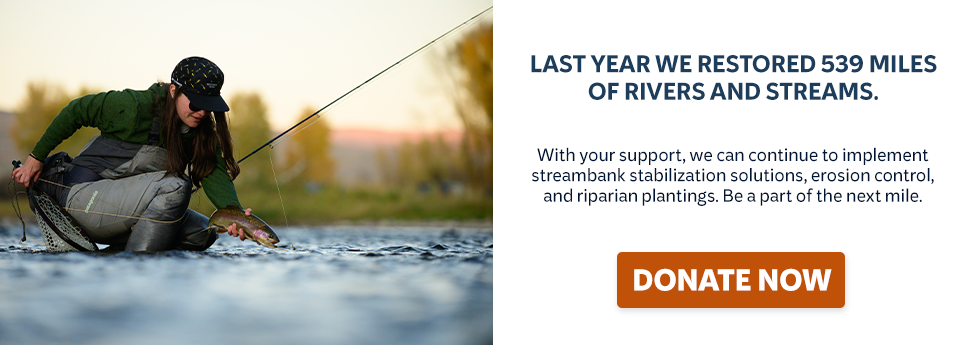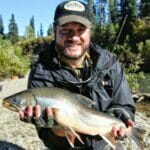Diana Miller with a migratory Yellowstone cutthroat caught in late June in the Thorofare area of the Bridger Teton National Forest in Wyoming. Dave Sweet photo.
By Dave Sweet
Reports have been circulating for several years about Yellowstone cutthroat trout returning to their upper Yellowstone River spawning redds above Yellowstone Lake. To see for ourselves, my daughter, Diana Miller, and I decided to pack into the Thorofare area of the Bridger Teton National Forest in Wyoming.
This was a return of sorts since Diana and I had last visited the Thorofare region, often referred to as the most remote place in the Lower 48, more than 20 years ago. Our recent trip during the last week of June included 26 miles of wilderness horse packing trails highlighted by passing the legendary “Parting of the Waters” where Pacific Creek flows west, and Atlantic Creek flows east. Both streams originate from the same stream (Two Ocean Creek) and split to flow to two different oceans on Two Ocean Pass.
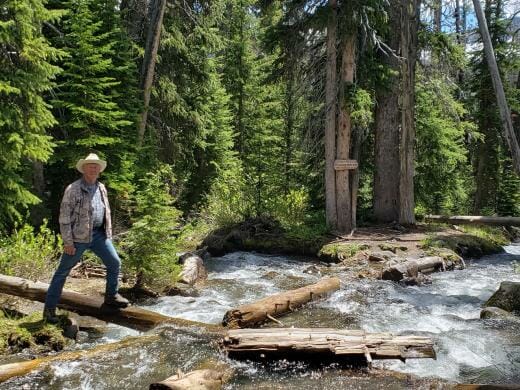
Dave Sweet standing near “Parting of the Waters” where a river splits with one side eventually leading to the Pacific Ocean and the other to the Atlantic Ocean. Diana Miller photo.
Being with my daughter in one of my favorite places was especially meaningful. The real reward for both of us was seeing, and catching, incredible numbers of Yellowstone cutthroat. Between the two of us, we probably landed well over 50 fish, obtained fin clips from 36 for genetic testing and saw literally thousands. Everywhere we went we saw, and caught, cutthroat. They were in Atlantic Creek, the mainstem Yellowstone River, and the Thorofare River. And they were spawning. Our trip was timed to catch the end of the spawn and we were successful.
The biggest fish caught was pushing 25 inches, healthy and fat – weighing more than 5 pounds. The average fish was 20-23 inches and the smallest were about 14 inches.
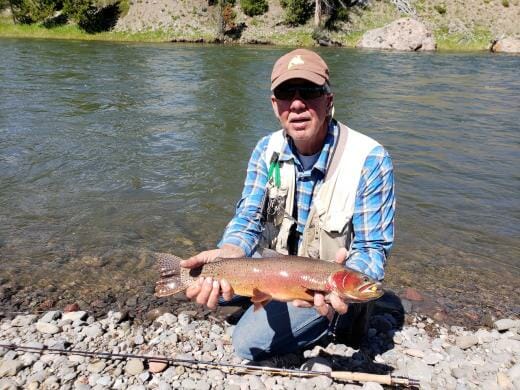
Dave Sweet with a Yellowstone cutthroat trout he landed in late June in the Thorofare area of the Bridger Teton National Forest in Wyoming. Diana Miller photo.
The other interesting part of the trip was the number of bald eagles and pelicans obviously keyed in on the trout. We didn’t see any bears, but I believe they are also aware that the cutthroat have returned to their natal streams. Anglers are also aware of the return as we saw several groups (both outfitted and on their own) experiencing this incredible fishery.
Seeing cutthroat back in their traditional spawning grounds and watching wildlife and other anglers enjoying them was tremendously rewarding as I reflected on the years of efforts to bring these amazing trout back.
Let me back up. I started learning about, and working on, the growing situation at Yellowstone Lake in Yellowstone National park more than a decade ago. Lake trout, a nonnative fish, had found their way into the Yellowstone Lake ecosystem almost 20 years ago, but their impact on the native Yellowstone cutthroat trout was largely unknown to me and to the general public. Only biologists working directly in the park knew the real story.
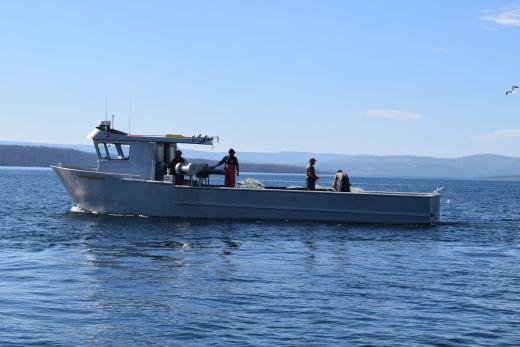
Efforts to cull nonnative lake trout from Yellowstone Lake are making a difference in helping native Yellowstone cutthroat trout numbers rebound. Brett Prettyman/Trout Unlimited.
Silently, lake trout had been preying on the cutthroat and increasing their numbers in the huge system. By then the impacts to the ecosystem were apparent, but not widely publicized. The National Park Service and officials in Yellowstone were close to ending their suppression efforts on lake trout.
Many of us recognized the depth of the problem and the almost inevitable loss of the largest remaining population of Yellowstone cutthroat on the planet. The U.S. Geological Survey, Greater Yellowstone Coalition, National Parks Conservation Association, Yellowstone Forever (then known as Yellowstone Park Foundation and of course, Trout Unlimited, among others, unified in an effort to reverse the trend.
Perhaps most importantly, new Yellowstone superintendent Dan Wenk engaged with the groups and set a new course; Yellowstone cutthroat would not become ghosts of their namesake lake on his watch.
Trout Unlimited, the USGS and funding partners responded by launching a huge telemetry effort to learn how lake trout move around the system and where they gathered to spawn. These two critical efforts were vital in increasing the number of lake trout removed. We also urged a new approach to focus on suppression on the early life stages of the lake trout – ova and fry.
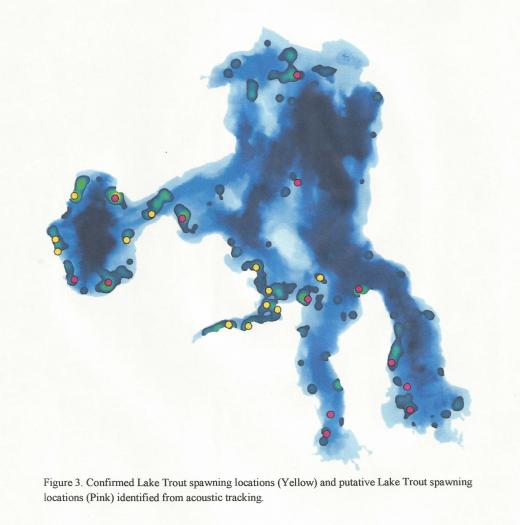
It has been a huge effort from all involved to reverse the trends of ever-increasing lake trout numbers and ever-declining cutthroat numbers. But reversal HAS occurred. The lake trout numbers peaked some 4 or 5 years ago, especially the adult population. It has since declined; slowly at first and more rapidly the last couple years. And, the cutthroat have started to show a comeback.
So, where are we headed? Everyone is looking for a lake trout population crash. Are we there yet? No, but we may be close. Declines in adult lake trout numbers are accelerating; and juvenile lake trout numbers may be following. The cutthroat fishery (and the ecosystem) are healthier than they have been for many years – our trip into the Thorofare for example. But we can’t rest. To do so would allow the lake trout numbers to once again grow with devastating impacts on the cutthroat.
We have a new superintendent coming to Yellowstone later this summer. His philosophy and strategies must keep up the good work started by those before him. Trout Unlimited can play a role by insisting native fish conservation on Yellowstone Lake continues to receive the highest priority and adequate funding.
Here’s some scientific evidence showing efforts to cull lake trout from Yellowstone Lake are helping the cutthroat rebound.
Summary of Lake Trout Suppression and Yellowstone Cutthroat Response 2017
The following is a summary of the information presented to the Yellowstone Lake Science Review Panel in April 2018 that updates the status of lake trout suppression in Yellowstone Lake for 2017 and the status of Yellowstone cutthroat trout recovery.
Lake trout suppression:
During 2017, six gill netting boats operated up to six days a week from late May until mid-October. A total of more than 90,000 units of effort (100 meters of net for one night is one unit). This represents a new high for total effort and for the first time, substantially exceeded the primary netting goal established in the Native Fish Conservation Plan in 2010. A new high of more than 397,000 lake trout were removed by netting. Of that number 213,000 were primarily age 2 lake trout. Adult lake trout catch was down 26 percent from 2016 despite a 17 percent increase in large mesh net set. This is part of an ongoing trend over the past several years whereby the Catch per Unit of Effort for adult lake trout has now declined consistently since 2008 from a value of almost nine lake trout per unit of effort to about 1.2 lake trout per unit. This despite a continuing increased knowledge of lake trout habits, movements, and locations (from telemetry and netting experience).
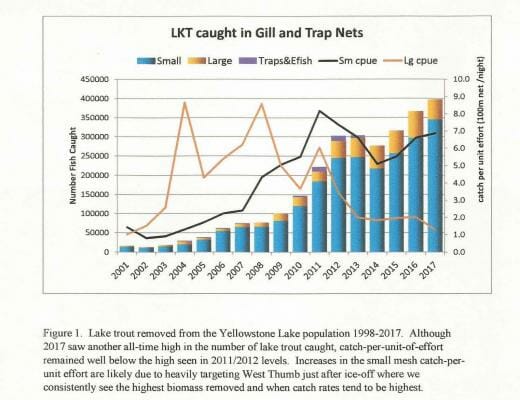
Lake trout population modeling:
The adult lake trout numbers are in significant decline. Population modeling shows the age 2 and older population peaked prior to the 2012 netting season at around 953,000 adult fish and has declined since that time to a level of about 800,000 at the start of the 2017 netting season and 300,000 at the end of the 2017 netting season. However, juvenile lake trout numbers remain high through recruitment or increased survival of lake trout ova and fry and continue to age into the adult population. Mature lake trout that are 6 years or older have decreased in abundance over 50% in that same time frame. Total biomass of lake trout has declined during this same time period in the Lake. At the current rate of netting (90,000 units), further population declines are anticipated for the next 4-5 years when the lake trout population will drop to less than 100,000 total adult fish. The population crash is not yet here, but we are getting closer. This is excellent news.
Telemetry:
During 2017 telemetry continued to be used to find lake trout spawning grounds and to aid the gill netting operation. A total of 570 lake trout were tagged in 2015-2017 and real time locations were determined and used to guide netting or to suggest spawning areas in the fall. A total of 14 spawning beds are now known (see Figure 3B and named spawning sites map attached). During this summer and fall the USGS used a Remote Operated Vehicle (ROV) to look for ideal spawning substrate and to confirm the presence of lake trout ova on spawning beds.
Ova/fry suppression:
The continued recruitment of juvenile lake trout entering the population points out the importance of ova and/or fry suppression. Ova suppression efforts are now focused on lake trout carcass (either whole or ground up) dumping on spawning beds. Also under evaluation is the use of a plant based carcass analog. Both are effective at substantial lake trout ova mortality in the lab and in controlled field studies. The lethality is via oxygen depletion or through the introduction of fungus and bacteria (see picture attached). A more widespread treatment of selected spawning beds with carcasses or carcass analog pellets is planned for 2018.
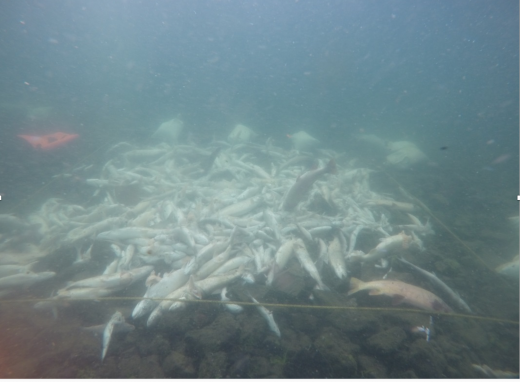
Dumping lake trout carcasses on known lake trout spawning beds is one way Yellowstone National Park fisheries officials are trying to control the population before fertilized eggs hatch. Courtesy photo.
Yellowstone Cutthroat Recovery:
A complete cutthroat trout population estimate for the Yellowstone Lake system has not been done. Population trend data is available from several sources. Key indicators are lake trout gill netting by-catch numbers, distribution netting aimed at cutthroats, angler surveys, and spawning tributary surveys. Most of these are trending higher. Based on the results from all of them, the consensus is that the cutthroat population is increasing and has been for the past couple years.
By-catch of cutthroats is up 23% from 2016 (netting effort increased 14 percent), but more than doubled in the smallest mesh used, suggesting strong cutthroat recruitment into the population.
Distribution netting of cutthroats was up about 20 percent from the 2015/2016 average.
Angler success for cutthroats was essentially unchanged from 2016.
Spawning stream surveys were not reported at the Science Review Panel but my trip to the Thorofare confirms a massive spawning migration.
A Final Note:
Preliminary 2018 lake trout gillnetting results are extremely positive. Through July 7, 2018 — and in comparison to the same time period in 2017 — the total number of lake trout caught is down 37 percent despite a 7 percent increase in effort. Almost all of the decline is in the smallest mesh nets; suggesting a decline in recruitment from 2 to 3 years ago.
Dave Sweet is the Yellowstone Lake Special Project Manager for Wyoming Trout Unlimited. Dave is a member of the Wyoming Outdoor Hall of Fame. He is based out of Cody, Wyoming.

Dave Sweet with a Yellowstone cutthroat trout landed in the Thorofare area of the Bridger Teton National Forest in Wyoming. Diana Miller photo.

